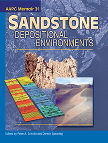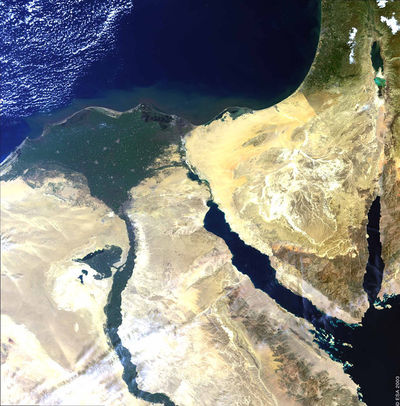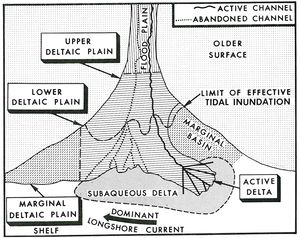Deltaic environments
| Sandstone Depositional Environments | |

| |
| Series | Memoir |
|---|---|
| Chapter | Deltaic environments of deposition |
| Author | J. M. Coleman and D. B. Prior |
| Link | Web page |
| PDF file (requires access) | |
| Store | AAPG Store |

Deltaic depositional facies result from interacting dynamics processes (wave energy, tidal regime, currents, climate, etc.), which modify and disperse riverborne (fluvial) clastic deposits. The term delta was first applied by the Greek philosopher Herodotus (490 B.C.) to the triangular land surface formed by deposits from Nile River distributaries. In the broadest sense deltas can be defined as those depositional features, both subaerial and subaqueous, formed by fluvial sediments. In many instances the deposition of fluvial sediments is strongly modified by marine forces such as waves, currents and tides, and depositional features found in deltas therefore display a high degree of variability. Depositional features include distributary channels, river-mouth bars, interdistributary bays, tidal flats, tidal ridges, beaches, eolian dunes, swamps, marshes, and evaporite flats.[1]
A significant deltaic accumulation necessarily requires the existence of a river system carrying substantial quantities of clastic sediment from an inland drainage basin to the coast, where the deposits form the delta plain. Modern deltas exist under a wide range of environmental processes; some deltas form along coasts experiencing negligible tides and minimal wave energy, whereas others form in areas where tide ranges are extreme and wave energy is intense. Despite the environmental contrasts, all actively prograding deltas have at least one common feature--a river supplies clastic sediment to the coast and adjacent shelf more rapidly than it can be dispersed by marine processes, and thus a regressive sedimentary deposit forms.

A delta plain generally can be subdivided into physiographic settings. Every delta plain consists of a subaerial and subaqueous component. The subaerial component is often divided into upper and lower delta plains (Figure 1), the upper plain normally being the older part of the subaerial delta and existing above the area of significant tidal or marine influences. Unfortunately, in ancient rock sequences, only faunal evidence can be used to separate these major components. The upper plain is commonly the continuation of an alluvial valley and is dominated by riverine processes. The lower delta plain lies within the realm of river-marine interaction and extends landward from the low-tide mark to the limit of tidal influence; thus a lower delta plain is most extensive in areas where tidal ranges are large and seaward gradients and topographic relief are low. The subaqueous delta plain is that part of the delta lying below the low-tide water level and contains relatively open marine fauna. It is the foundation across which subaerial delta deposits must prograde. The subaqueous delta is most commonly characterized by a seaward fining of sediments, sands and coarser clastics being deposited near the river mouths and finer grained sediment dispersing farther seaward. In most deltas, the coast of the delta plain receives dissimilar rates of sediment introduction, and it is not unusual for one part of the delta shoreline to be rapidly prograding seaward, while other parts are subjected to reworking by marine processes. If wave and current reworking are intense, the delta shoreline undergoes landward transgression, and coastal barriers, beach or dune complexes will often be formed. In other places, particularly when subsidence rates are high, marine waters encroach rapidly across the subsiding delta mass and shallow-water marine deposits will directly overlie the regressive delta deposits with no significant marine reworking taking place.
To systematically describe the sedimentary characteristics of deltaic deposits, it is convenient to subdivide the sedimentary facies into the following categories:
- Upper delta plain
- Lower delta plain
- Bay-fill deposits (interdistributary bay, crevasse splay-natural levee, marsh)
- Abandoned distributary-fill deposits
- Subaqueous delta plain
- Distributary-mouth-bar deposits (prodelta distal bar, distributary-mouth bar)
- River-mouth tidal range deposits
- Subaqueous slump deposits
See also
References
- ↑ Coleman, J. M., 1976, Deltas: Processes of deposition and models for exploration: Continuing Education Publication Company, Champaign, IL, 102 p.
- ↑ Coleman, J. M., and D. B. Prior, 1981, Deltaic environments of deposition in P. A. Scholle and D. Spearing, eds., Sandstone depositional environments: AAPG Memoir 31, p. 139-178.